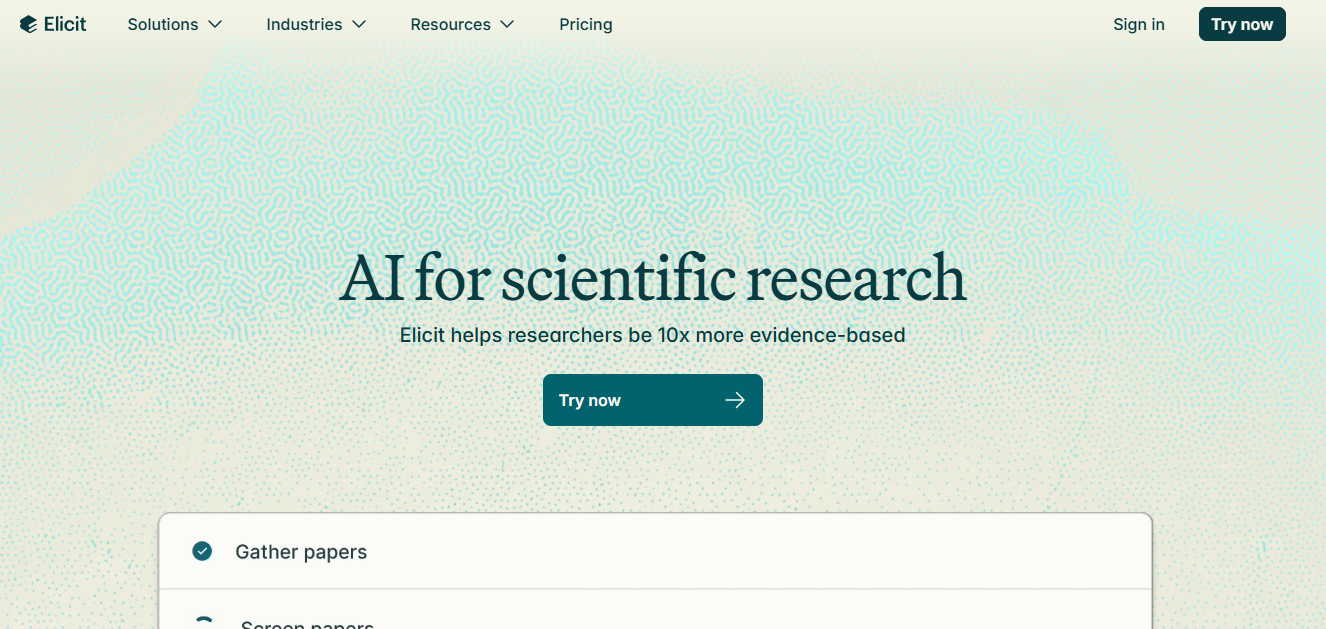
Elicit AI: Transforming the Future of Scientific Research

Key Highlights
- Elicit is an AI research assistant that leverages artificial intelligence to transform scientific research. It provides automation for key research workflows, particularly the literature review process. The platform helps you find relevant research papers from the Semantic Scholar database without perfect keyword matches.Users frequently praise Elicit for streamlining their literature review process and saving valuable time. Many report that the AI research assistant improves the efficiency and accuracy of finding relevant research papers, helping them manage complex research workflows with ease. Overall, feedback indicates that automation through Elicit enhances the overall research experience.
- It provides automation for key research workflows, particularly the literature review process.
- The platform helps you find relevant research papers from the Semantic Scholar database without perfect keyword matches.
- Its key features include AI-powered search, automated summarization of papers, and data extraction.
- Elicit streamlines systematic reviews by organizing findings into an easy-to-use table.
- You can use it to brainstorm research questions and discover new academic papers efficiently.
Introduction
Are you looking for a way to make your research process faster and more efficient? The world of scientific research is rapidly evolving, thanks to advancements in artificial intelligence. Tools like Elicit are at the forefront of this change, acting as a powerful AI research assistant. This platform is designed to automate time-consuming tasks, helping you analyze papers, extract data, and synthesize findings with remarkable speed. Imagine having a smart assistant to help you navigate the vast sea of academic literature.
Understanding Elicit AI and Its Role in Scientific Research
Elicit is a dedicated AI research assistant developed by Ought, a nonprofit machine learning research lab. It uses advanced language models, like GPT-3, to automate parts of your research workflow. The primary goal is to expedite the scientific research process, making it easier for you to find and understand relevant studies.
Think of it as your partner in evidence synthesis and text extraction. When you enter a research question, this AI research assistant scours the Semantic Scholar database to identify top papers, summarize their findings, and organize key information for you. This approach helps you focus on analysis rather than manual searching. The following sections will explore what makes Elicit unique and how it is applied in the real world.
What Sets Elicit AI Apart from Traditional Research Methods
Traditional research methods often involve hours of sifting through databases with specific keywords. Elicit changes this dynamic completely. Instead of relying on exact keyword matches, it uses a process-based machine learning system to understand the intent behind your research question. This allows the AI research assistant to find relevant papers even if your query isn't perfectly phrased.
Unlike just searching databases like Semantic Scholar manually, Elicit actively synthesizes information. It doesn't just give you a list of titles; it extracts key details like interventions, outcomes, and participant numbers, presenting them in a structured table. This automation streamlines the entire research process, saving you a significant amount of time.
This focus on process supervision rather than just outcomes allows the system to perform complex tasks and provide differential capabilities. As one source notes about this approach, process-based ML systems provide “better differential capabilities.” [1] This makes Elicit a more dynamic and intuitive tool compared to conventional search methods.
[1] https://www.lesswrong.com/posts/pYcFPMBtQveAjcSfH/supervise-process-not-outcomes
Real-World Applications of Elicit AI in Science
The practical use cases for Elicit span numerous academic and scientific fields. Its ability to act as a responsive AI research assistant makes it valuable for students, independent researchers, and academic organizations alike. Have you ever struggled to get started on a literature review? Elicit can significantly speed up this task.
By simply asking a research question, you can quickly find relevant research papers and see a summary of their key findings. This is particularly helpful for exploring a new domain or narrowing down a broad topic. Elicit helps you find papers you might have missed with traditional search methods, including those in niche subject areas.
Some of its most common applications include:
- Speeding up the literature review process.
- Finding papers that are not easily accessible through other search methods.
- Automating systematic reviews and meta-analyses.
- Learning about a new academic field or domain.
- Brainstorming and refining a research question.
Core Features of Elicit AI for Researchers
Elicit is packed with key features designed to support your academic research. At its core, the platform uses artificial intelligence to interpret your queries and deliver relevant results. The advanced language models powering Elicit can understand complex scientific concepts, making your search for information more intuitive and effective.
Whether you're summarizing papers, extracting data, or analyzing citations, Elicit provides tools to make each step easier. The following sections will highlight some of these core capabilities, such as its AI-powered paper discovery and automated summarization tools.
AI-Powered Literature Review and Paper Discovery
Performing a literature review can be one of the most demanding parts of a research project. Elicit’s AI-powered search feature is designed to simplify this task. Unlike conventional search engines such as Google Scholar, where you rely on keywords, Elicit allows you to ask a question in natural language. The AI then finds scientific papers based on the substance of your query.
This method helps you discover relevant research papers without getting bogged down by irrelevant documents. The system searches a corpus of over 200 million academic papers, ensuring comprehensive coverage. This makes it much easier to find valuable research without spending endless hours sorting through search results.
You can also use Elicit to explore and brainstorm research questions, narrowing or adjusting your direction as you go. The platform can even summarize evidence from the most cited papers on a topic, giving you a quick overview of the most influential work in the field.
Automated Summarization and Citation Analysis
One of Elicit's most powerful key features is its ability to provide automated summarization of complex academic papers. The tool generates concise, easy-to-understand summaries, allowing you to grasp the key insights of a study without reading the entire document. This is a huge time-saver, especially when you're screening a large number of articles.
Beyond summarization, Elicit offers valuable citation analysis. By analyzing the citations of scientific papers, you can gain insights into the credibility and impact of a particular study. The platform displays citation counts and provides a DOI link that redirects you to the original source. This helps you understand a paper's significance within its academic context.
This feature pulls information from bibliographic databases and even includes the SCImago Journal Rank, which quantifies a journal's prestige. This additional context is incredibly useful for assessing the authority of authors and publications during your research process.
Integrating Elicit AI Into the Research Workflow
Incorporating Elicit into your daily research workflows is straightforward and can dramatically improve your productivity. The platform is designed to automate many of the manual steps in the research process, from initial discovery to final data extraction. Its simple interface allows new users to quickly grasp its functionality without extensive training.
By handling tasks like paper screening and summarization, Elicit frees you up to focus on more analytical work. You can customize columns to extract specific information, save results, and even upload your own papers for analysis. The following sections will explain how to streamline specific tasks like systematic reviews and enhance team collaboration.
Streamlining Systematic Reviews with Elicit AI
Systematic reviews demand a rigorous and transparent approach, which can be incredibly time-intensive. Elicit is particularly effective for streamlining the systematic review process by automating data collection, synthesis, and analysis. You start by asking a clear research question, and Elicit retrieves relevant studies from its data sources.
The tool then extracts key information from each paper and organizes it into a structured table. You can filter topics from each abstract, including interventions, outcomes, and the number of participants. This automation significantly reduces the manual effort required for screening and data extraction, making your review more efficient.
Elicit is ideal for questions that have empirical research, such as those in biomedicine structured as "What are the effects of x on y?" The platform's ability to condense information into component parts makes it a powerful asset for any researcher conducting systematic reviews.
Systematic Review Step
How Elicit AI Helps
Define Research Question
Brainstorm and refine questions within the Elicit platform.
Literature Search
Ask your question to find relevant papers from its database.
Screening Papers
Review AI-generated summaries to quickly include or exclude studies.
Data Extraction
Automatically pull specific details (e.g., population, outcomes) into a table.
Synthesize Findings
View extracted data from all papers in one organized matrix for easy comparison.
Enhancing Collaboration and Knowledge Management
Elicit isn't just for individual researchers; it also offers features that enhance team collaboration and knowledge management. When working on a project with colleagues, sharing and discussing research findings is crucial. Elicit makes this process seamless.
The platform's summarization features allow team members to quickly get up to speed on a collection of papers. With enterprise and institutional subscriptions, you can share credits across your organization, ensuring everyone has access to the tool's advanced language models. The ability to export results to formats like CSV and BIB also helps integrate findings into shared reference managers.
Here’s how Elicit supports collaboration:
- Teams can quickly share and discuss AI-generated summaries of research.
- Results can be exported and integrated into collaborative tools like Zotero.
- Shared access under institutional plans promotes a unified research workflow.
- Starred papers can be stored and revisited by any team member.
Evaluating the Effectiveness and Limitations of Elicit AI
While Elicit is a powerful tool, it's important to approach it with a balanced perspective. When using any AI, a healthy dose of wariness regarding accuracy and reliability is wise. The platform offers incredible usability, but understanding its limitations is key to using it effectively for scientific research.
No tool is perfect, and Elicit is no exception. Its effectiveness depends on the type of research question and the available literature. The following sections will cover the platform's accuracy in scientific contexts and discuss some common challenges users might encounter.
Accuracy and Reliability in Scientific Research
When it comes to scientific research, accuracy is paramount. Elicit enhances reliability by grounding its results in published academic papers. Unlike some generative AIs that can "hallucinate" sources, Elicit pulls directly from the Semantic Scholar database, ensuring that its summaries and data extractions are based on real, citable work. This provides valuable insights, especially for empirical research.
However, the accuracy of the extracted information still requires human oversight. The AI summarizes content, but it's always a good practice to refer back to the original paper to verify critical details. The tool is designed to be a research assistant, not a replacement for a researcher's critical judgment.
Elicit is most reliable for topics with a substantial body of empirical research, such as questions about interventions and their effects. By cross-referencing the AI's output with the source material, you can confidently leverage its speed without sacrificing the integrity of your work.
Common Challenges and Limitations Users Encounter
Despite its impressive usability, Elicit has some limitations that you should be aware of. One of the main challenges is its reliance on a single database. The platform is limited to publications available in Semantic Scholar, which means it may miss articles from licensed journals or those behind paywalls.
Another limitation is its search functionality. The system encourages full research questions and does not support traditional search syntax like truncation or controlled vocabulary. This means you need to ask the right questions to get the right papers. Additionally, some features, like the inability to un-star items or organize starred lists, can feel unintuitive during the research process.
Here are a few common limitations:
- Its literature search is confined to the Semantic Scholar database, which is smaller than Google Scholar.
- The search interface does not support keyword syntax or advanced search operators.
- Accidental deletions of papers from a results list cannot be undone.
- The data extraction is dependent on the availability of full text or a detailed abstract.
KeywordSearch: SuperCharge Your Ad Audiences with AI
KeywordSearch has an AI Audience builder that helps you create the best ad audiences for YouTube & Google ads in seconds. In a just a few clicks, our AI algorithm analyzes your business, audience data, uncovers hidden patterns, and identifies the most relevant and high-performing audiences for your Google & YouTube Ad campaigns.
You can also use KeywordSearch to Discover the Best Keywords to rank your YouTube Videos, Websites with SEO & Even Discover Keywords for Google & YouTube Ads.
If you’re looking to SuperCharge Your Ad Audiences with AI - Sign up for KeywordSearch.com for a 5 Day Free Trial Today!
Conclusion
In conclusion, Elicit AI represents a transformative leap in the realm of scientific research, enabling researchers to harness the power of artificial intelligence for more efficient and effective outcomes. By automating literature reviews, streamlining systematic reviews, and enhancing collaboration, Elicit AI not only saves time but also increases the accuracy and reliability of research findings. As researchers continue to navigate the complexities of data and information, adopting tools like Elicit AI can be a game changer in their workflow. If you're eager to explore how Elicit AI can elevate your research process, we invite you to get a free demo today!
Frequently Asked Questions
Can Elicit AI help identify relevant sources for niche topics?
Yes, Elicit's AI research assistant can be very helpful for finding relevant studies on niche topics. Because it understands natural language, you can ask a specific research question without needing perfect keywords. It can often uncover relevant studies that traditional search methods might miss, making it great for a focused literature review.
How does Elicit AI compare to other research assistant tools?
Elicit’s main focus is on automating literature review workflows by synthesizing information from bibliographic databases. While other tools like ResearchRabbit map connections, Elicit uses advanced language models to extract and summarize data directly. Its usability is high, with a simple interface designed for answering research questions, which sets it apart.
Is there a cost to using Elicit AI or are free alternatives available?
Elicit offers a free basic subscription with a one-time credit allotment, making the app accessible to everyone. For more extensive use, there is a "Plus" subscription with a monthly cost. Free alternatives for finding papers include tools like Google Scholar and ResearchRabbit, though they offer different functionalities than this AI research assistant.

